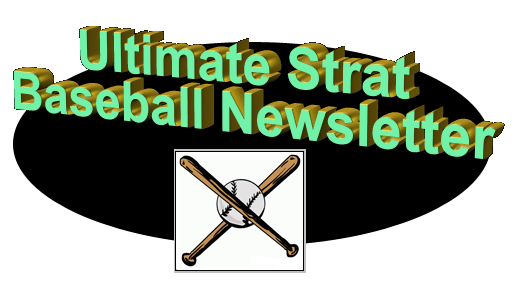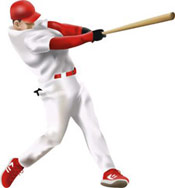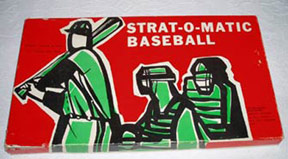Vol. II,
Issue #4 - October 2014
**
Extreme Ballparking
- Chuck Tinkler
**
(Now this is what we are talking about -- Chuck is a member of
our newsletter and came
forward with this great article to share with all our members.
We bet you will be hearing
more from this Strat brother in future issues, so stay tuned
.............................. )
(Bio on Chuck:
Chuck is from the Long
Beach area of California and has been playing
Strat-O-Matic off-and on for about 25 years. He
currently plays in two leagues, Polo Grounds
Baseball and the Bigs Winter League. His Strat
interests include finding slick ways to cause a team
to outperform expectations and irritating his league
mates by talking lots of smack about it. Chuck
is always likes to chat about Strat, Hal settings
and ballpark dimensions in particular, so feel free to email him with questions or
comments related to this article -- his email is
listed at the end of this amazin' article = thank you Chuck!!)
 Extreme
Ballparking
Extreme
Ballparking
Figuring out what
ballpark dimensions to choose is as perplexing of a task as
there is for us Strat GM's.
We want our hitters to rake and our pitchers to dominate, but we
can't have both! At least, one can't be helped without hurting
the other. And even when we do decide one way or the other, how
do we know that our choice won't end up helping our opponent
more than ourselves? There are so many factors at play sometimes
that it seems impossible to really make sense of it all. While
knowing the exact right situation for every team in every
circumstance is impossible, there are certainly general trends
and strategies that do apply across the board and are definitely
worth considering. With that in mind, let's take a closer look
at just what a choice of ballpark might do (or not do) for your
ballclub.
Back in the early 1990's,
I played in a league with
Joe Sheehan
(he was with Baseball Prospectus, is on ESPN every now and
again, does lots of baseball stuff). Surprisingly, his team
wasn't all that good, but he probably wasn't taking things all
that seriously. Anyways, he made a comment one time though about
ballparks that went something like, "Oh yeah, it's really not
that difficult. You get a team filled of hitters with diamonds
(ballpark homeruns), pitchers without diamonds, move to
Colorado, and that's it". This was said during the steroid era
and before Coors brought in a humidor. It was a time when Coors
was a guaranteed homer-to-19 ballpark and the league was filled
with guys with diamonds all over their cards. Back then this was
much more of an obtainable outcome than it is now. Most of us
have probably thought this same thing at some point, but in this
conversation what I think he was really getting at was this:
Ballparks are the only control that we have over what the cards
contain. And with that power should we squeeze every
last stinking drop of advantage we can out of
it.
There are two extremes
really for us Strat GM's. We'll call them
"Coors"
and the
"Astrodome". For
our purposes, we'll say Coors is 1 - 19 all around and the
Astrodome is 1 - 1 all around (singles and homeruns). By picking
one of the extremes and creating a team best-suited for it, what
we are doing is creating an environment that our opponent is not
nearly as likely to benefit from as we are. If we look across
our leagues, very few teams will have gone completely in one
direction or the other, therefore it is highly unlikely that
someone will have the right combination of players to come into
this extreme environment and derive greater benefit from it. By
going full blast the one way or other, we are increasing the
value of certain attributes and decreasing the value of others.
The trick of course then is
getting a team full of guys with those desirable attributes.
Before delving into what such a team would look like, consider
this: a run scored in the Astrodome is worth more than a
run scored at Coors. This make take a minute to sink in,
but if you think about it, it's true. We'd be better off hitting
a grand slam in the first inning in the Astrodome than we would
at Coors. If we were to take this and apply it to player's
values, players then have different values in different places.
Furthermore, if a run is worth more in the Astrodome than in
Coors, then allowing a run in the Astrodome is more detrimental
than allowing one in Coors. A player who is poor defensively
then is less valuable in the Astrodome and one who is great
defensively is worth more there. And so on it goes through each
attribute. Each attribute varies in worth depending upon the
circumstances where this attribute will be utilized.
It goes without saying that
we always want to score more than we allow in any environment.
That's the nature of the game. But because these environments
affect attributes the way they do, the response is to focus our
resources towards either scoring runs or stopping them from
being scored, ie, we want to pick the way we are going to
stretch our run differentials and max it out. We want to use
Coors to manufacture a ridiculous amount of runs and use the
Astrodome to help us stop runs from being scored. We want to
emphasize the advantages that these extreme environments offer
to the fullest extent possible. We want to take our limited
resources and invest them in such a way as to take the utmost
advantage from this environment we've chosen to reside in. Our
resources are "limited" because we don't have the option of
having a Tulo at every position. At least if we did, it wouldnít
matter what park we played in. What we do have is a roster full
of guys with certain strengths and certain weaknesses. Our goal
with our ballpark then is to put these players in the
environment that emphasizes their strengths, hides their
weaknesses, and in the end sneaks wins away from our opponents.
Babe Ruth in Coors. It'd
be ridiculous, wouldn't it? What would he hit, like 70 or 80
homeruns each year? What about a lineup full of Babe Ruths? That
would be insane! What it would be is an offense that couldn't
possibly be bested in that environment. And that's what we are
after - an environment in which we will have the advantage 100%
of the time. The same is true for the Astrodome. A rotation full
of Clayton Kershaws in the Astrodome could effectively be the
same thing. Whereas Coors amplifies the Babe's ability to hit
homeruns, the Astrodome amplifies Kershaw's ability to stop runs
from scoring. What we are doing by going the extreme route and
selecting Coors is challenging our opponents to outscore us.
By choosing the Astrodome,
we are challenging our opponents to try to score on us. And
because winning by 1 run or 20 runs doesnít matter, all we have
to do is create an environment that will help us have more runs
(even just 1 more) when the last out is recorded. If Team
Astrodome wins 2 - 1, it counts the exact same as Team Coors
winning 14 - 10. The entirety of the trick then is using our
ballparks to help bring about this outcome - us having more runs
than our opponents when the game comes to an end. Bringing that
about doesn't require a lineup full of Babe Ruths, but does
require a team full of guys that are designed in a way to thrive
in the environment they are being placed in.
To create the environment
that favors our teams involves many factors beyond those
discussed already. First off, the Astrodome team has to allow
just the 1 run and find a way to score 2. In
other words, playing in the Astrodome requires a defense to
support the pitching and an offense that can score at least some
in that environment. Equally, the team at Coors must have decent
enough pitching and defense to keep the opposition to scoring
just the 10 runs. And to that end, the teams must be built in a
way that matches the environment in which they play. It is
critical that Team Astrodome has a high batting average. This
team also needs very strong defense to support the pitching - a
triple past the leftfielder in this environment can be
devastating. The Coors team on the other hand needs to pitch
just well enough and play just enough defense to allow for the
offense to muscle its way past the opposition. Hitting in all
forms should be the focal point for Team Coors with on-base and
slugging being at the top of the list. Team Astrodome wants high
average, slick fielding, speedy guys; Team Coors wants a decent
pitching staff (skewed towards low diamonds and high GBA's), a
great bullpen (it's cheap), decent defenders, and hitters with
tons of diamonds. Homerun hitters in the Astrodome
are fine as are great defenders in Coors, but only if they have
their highly needed attributes in place first.
An Adam Dunn kind of guy
would have some decent value in Coors but is beyond worthless in
the Astrodome. The balls that would get by him and low batting
average would hurt the team far more than the few homeruns he
would hit would help. A similar situation would exist for an
Ichiro-type guy in Coors. His defense (what's another hit at
Coors?) and speed (who wants to steal there?) lose
value and his lack of power becomes a glaring weakness. Ichiro
wouldn't be a Dunn-type disaster by any means, but he wouldn't
be close to bringing the greatest return on the resources that
have been taken up to have him. Itís for reasons such as these
though that opponents whose team aren't well suited for these
environments can be made to suffer. The opponent who plants the
Big Donkey in LF in the Astrodome just gave the Astros a huge
jump towards getting the 2 runs they need to win the game. If
the ball is hit to him and he gives up a double, that could very
easily be the ballgame.
Not only that, but in Strat,
missed ballpark homeruns aren't doubles, or anything
positive, they are OUTS. So not only is Dunn a total bust
in the outfield, not only is he going to hit maybe half the
homeruns here that he might elsewhere, but all those diamonds
that he worked so hard to get now benefit the opposition.
Now those diamonds actually help the opponent. So not only does
the ballpark then have the ability to boost our player's values,
it has the ability to hamper the opponent's players who are
unsuited for it. Through ballparks then we have the ability to
turn our opponent's card values against them. Most teams
are way more dependent upon homeruns for scoring than they know
and using a ballpark to take these runs away can be a huge
advantage for the rightly prepared home team.
There are of course road
games. But because most teams have mid-range, 50/50ish
ballparks, setting the team to one extreme or the other might
not be felt that strongly in other parks. The solution of course
would be to keep enough variety on the bench to help adjust to
other environments and/or have core guys that can make the
transition between environments. Where these teams could really
struggle though is playing in each other's parks, ie, the Astros
in Coors and vice versa. Comparing the two, Team Coors almost
certainly would have a much harder time in the Astrodome than
the opposite. Whereas Team Astrodome could use batting average
and on-base to score at Coors Field, Team Coors, missing diamond
after diamond, would have a much harder time overcoming what
their mediocre defense and pitching would allow in the
Astrodome. If you've ever played in or against someone in these
type of environments you know that itís a heck of a lot harder
to plate 3 runs of a Kershaw-type guy than out-score someone in
the madhouse that is Coors. If the game has a slant then this is
what it would be - the properly placed team in a pitcher's park
can cut through a league like a hot knife through butter.
The question though that
teams most often find themselves asking goes something like
"What's the best park for my team? or "How should I adjust my
park for the team I have?". But the questions that we really
want answered is "How do I use my ballpark to work to the
greatest extent in my favor?". The solution is to not
pick or adjust a park to fit the team, but to fit or adjust the
team to the park. If the team has been created first, without
paying much of any attention to the park, then its highly
unlikely that the right collection of guys will be in place for
really taking advantage of things, regardless of the dimensions.
Some players will benefit, some will suffer, and in the end it
the whole thing will be just an opportunity lost. But by picking
the strategy, matching it with the right park, then bringing in
players that best match the system, a team can turn their
home-field into a significant advantage to be gained, 81+ times
a year.
Chuck Tinker
(NOTES from the Wolfman:
We want to thank Chuck for this most interesting article about
ballparks as he makes some very good points to consider when
trying to get your team to perform at its best in all the
different parks. Also the life of this newsletter is
through a
co-creation via the editing team and its members and we are
always open to consider to share good and thoughtful articles from
our members. So
thank you Charles for becoming a new contributor. Chuck is
waiting to chat with you: )
|
Support the Cause
If you are enjoying
the content and information our newsletter shares with you, why
not support us with your helpful donation for our minor expenses
and time?
|
Contained inside this exciting issue of Ultimate Strat
Baseball Newsletter:
(to view the various interviews, articles, columns and special sections click on
the links {underlined}
and this will take you to the appropriate
webpage)
♦
RETURN TO NEWSLETTER MAIN PAGE
♦
INTERVIEW
with JEFF FLEISCHMAN,
Commissioner of GUSSOMO, the oldest league.
♦
INTERVIEW with
BILLY SAMPLE,
ex-MLB player from 1978-1986 returns with more to tell!
♦
INTERVIEW with MARK
HEIL,
the creator of SOMers, an on-line SOM forum
♦
SOM BASEBALL ONLINE REPORT with WOLFMAN SHAPIRO PART II
--
editor of "The Ultimate Strat Newsletter" and 2012 CBA
Champion, the "Wolfman"
explores a whole new world of playing the SOM Baseball game
through the online gaming system which Strat-o-matic Offers. In
2001/2002, Strat-o-matic agreed with The Sporting News to offer
a version of their game which could be played completely on-line
using a web browser. In 2012, SOM told full charge of this
system and there is a whole community now of people who are involved
in all type of draft leagues including a unique style of holding tournaments. In this issue, "Wolfman"
shares his experiences and what he learned in participating in
his first league via the Barnstormers tournament, one of the
largest SOM Baseball Tournaments on the planet which challenges
you to the upmost. And finally he introduces you to another
veteran player of this style of play who has a lot to share
should you decide (if you are not already active) play in this
version of SOM baseball. To view this two part report, click on the links of the articles
to read shown below:
ARTICLE: How Did
the Wolfman do in his 1st Season? (Barnstormers
Tournament)
INTERVIEW with MESQUITON (D.
Merzenich), Experienced Online SOM Baseball
Player
♦
COMMISSIONER's CORNER with MARC WASSERMAN
--
commissioner of the Cyber Baseball Association (CBA) continues
his column about what it is like to be a League Commissioner.
In this
article,
he focuses upon what happens in various leagues
in October when the leagues begin their playoffs to discover
their league champions, quite interesting to read how the
leagues do this.
♦
RECOMMEND
ON-LINE SOM RESOURCES
-- On-line Strat-o-matic and Baseball related websites
that offer amazing information, special tools and products to improve
your game play
that we strongly recommend. In most cases, we have had personal contact with
these sources who agree with the principle to work together and help promote each other.
♦
BOOKS TO
DIE FOR and Become a BASEBALL GURU
-- This page
is
specifically about special books we are finding that either will
expand your insights about the game of Baseball, help you in the
creation of your current league teams or with your replays and
learn more about the Strat-o-matic
Baseball Game and Game Company's
history. We
have a special arrangement with Acta Sports, who is a publisher
of a number of great baseball books (including Bill James
Handbooks) to offer for our members
a 10% discount. We will continue to add more books to this page in the future
as we uncover other gems our members should know about.
Contact Us for Questions or Submissions:
Wolfman Shapiro
Founder/Editor, the
Ultimate Strat Baseball Newsletter
email:
wolfman@ultimatestratbaseball.com
facebook:
www.facebook.com/wolfman.shapiro
twitter:
@StratBaseball4U




